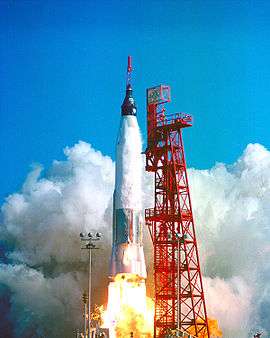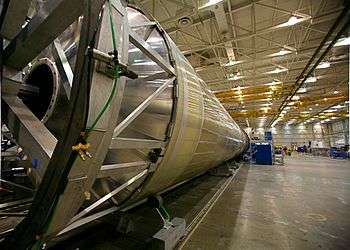Medium-lift launch vehicle
A medium-lift launch vehicle - MLV a rocket orbital launch vehicle that is capable of lifting between 2,000 to 20,000 kg (4,400 to 44,100 lb) of payload into Low Earth orbit - LEO.[1]
Medium-lift launch vehicles

Launch of an Atlas B intercontinental ballistic missile

Launch of the first American manned orbital space flight Atlas and Friendship 7

A Falcon 9 v1.0 launches with an uncrewed Dragon spacecraft, 2012

Falcon 9 booster tank at the SpaceX factory, 2008
| Vehicle | Origin | Manufacturer | Mass to LEO (kg) |
Mass to other orbits (kg) |
Launches | Status | First flight | Last flight |
|---|---|---|---|---|---|---|---|---|
| R-7 Semyorka Soyuz | RSC Energia TsSKB-Progress | Operational | 1957 | |||||
| Atlas (A-B-C-D-E-F-G-H-I) | Lockheed | Retired | 1957 | 1997 | ||||
| Delta | Douglas | Retired | 1960 | 1989 | ||||
| Saturn I | Chrysler & Douglas | 9,070 | 2,220 to TLI | 10 | Retired | 1961 | 1975 | |
| Atlas-Centaur | Lockheed | 148 | Retired | 1962 | 1983 | |||
| Titan II GLV | Martin | 3,580 | 12 | Retired | 1964 | 1966 | ||
| Titan IIIC | Martin | 13,100 | 3000 to GTO 1200 to TMI |
36 | Retired | 1965 | 1982 | |
| Proton-K | Khrunichev | 19,760 | 311 | Retired | 1965 | 2012 | ||
| Soyuz original | OKB-1 | 6450 | 32 | Retired | 1966 | 1975 | ||
| R-36 Tsyklon | Yuzhmash | Operational | 1967 | |||||
| Soyuz-L | OKB-1 | 5,500 | 3 | Retired | 1970 | 1971 | ||
| Long March 2-3-4 | China Academy of Launch Vehicle Technology | Operational | 1971 | |||||
| Titan IIID | Martin | 12,300 | 22 | Retired | 1971 | 1982 | ||
| Soyuz-M | OKB-1 | 6,600 | 8 | Retired | 1971 | 1976 | ||
| Soyuz-U | TsSKB-Progress | 6,900 kg from Baikonur and 6,700 kg from Plesetsk |
784 | Operational | 1973 | |||
| Titan IIIE | Martin Marietta | 15,400 | 3,700 to TMI | 7 | Retired | 1974 | 1977 | |
| N-I & II[2] | Mitsubishi Heavy Industries | Retired | 1975 | 1987 | ||||
| Soyuz-U2 | TsSKB-Progress | 7,050 | 72 | Retired | 1982 | 1995 | ||
| Zenit | Yuzhnoye | Operational | 1985 | |||||
| H-I | Mitsubishi Heavy Industries | 3,200 | 1,100 to GTO | 9 | Retired | 1986 | 1992 | |
| Ariane 4 | Aérospatiale | 7,600 | 4,800 to GTO | 116 | Retired | 1988 | 2003 | |
| Delta II | United Launch Alliance | 6,100 | 2,170 to GTO 1000 to HCO |
153 | Operational | 1989 | ||
| Atlas II | Lockheed | 6,580 | 2,810 to GTO | 63 | Retired | 1991 | 2004 | |
| PSLV | ISRO | 3,800 | 1,750 to SSO 1425 to GTO |
37 | Operational | 1993 | ||
| UR-100N Rokot Strela | Eurockot Khrunichev | Operational | 1994 | |||||
| H-II, IIA & IIB | Mitsubishi | Operational | 1994 | |||||
| Athena I & II | Lockheed ATK | Retired | 1995 | 2001 | ||||
| Delta III | Boeing | 8,290 | 3,810 to GTO | 3 | Retired | 1998 | 2000 | |
| Dnepr | Yuzhmash | 4,500 | 2,300 to GTO 550 to TLI |
22 | Operational | 1999 | ||
| Soyuz-FG | 6,900 | 56 | Operational | 2001 | ||||
| GSLV Mk.I & II | ISRO | Operational | 2001 | |||||
| Atlas V | United Launch Alliance | 18,810 | 8,900 to GTO | 65 | Operational | 2002 | ||
| Atlas III | Lockheed Martin | 10,218 | 4,500 to GTO | 6 | Retired | 2003 | 2005 | |
| Soyuz-2 | TsSKB-Progress | 8,200 | 4,900 to SSO 3250 to GTO |
62 | Operational | 2004 | ||
| Falcon 9 v1.0 | SpaceX | 10,450 | 4,540 | 5 | Retired | 2010 | 2013 | |
| Vega | Avio | 1,430 to polar 1330 to SSO |
7 | Operational | 2012 | |||
| Antares | Orbital Sciences | Operational | 2013 | |||||
| Falcon 9 v1.1 | SpaceX | 13,150 | 4,850 to GTO | 15 | Retired | 2013 | 2016 | |
| GSLV Mk.III (LVM3) | ISRO | 8,000 | 4,000 to GTO | 1 | Operational | 2014 | ||
| Angara 1.2[3] | Khrunichev | Operational | 2014[4][5] | |||||
| Falcon 9 full thrust (reusable configuration)[6][7] | SpaceX | 5,500[8] to GTO | 8 | Operational | 2015 | |||
| Long March 7 | China Academy of Launch Vehicle Technology | 13,500 | 5,500 to SSO | Operational | 2016 | |||
| Unified Launch Vehicle | Indian Space Research Organisation | 15,000 | 6,000 to GTO | 0 | Development | |||
| Super Haas | ARCA Space Corporation | Development |
See also
- Sounding rocket non orbiting
- Small-lift launch vehicle capable of lifting up to 2,000 kg to low Earth orbit.
- Heavy lift launch vehicle capable of lifting between 20,000 and 50,000 kg to low Earth orbit.
- Super Heavy lift launch vehicles capable of lifting more than 50,000 kg (110,000 lb) of payload into LEO.
- Comparison of orbital launch systems
- Comparison of orbital rocket engines
- Comparison of space station cargo vehicles
- Rocket
- Spacecraft propulsion
References
- ↑ NASA Space Technology Roadmaps - Launch Propulsion Systems, p.11: "Small: 0-2t payloads, Medium: 2-20t payloads, Heavy: 20-50t payloads, Super Heavy: >50t payloads"
- ↑ "N-2". Encyclopedia Astronautica. Retrieved 12 June 2013.
- ↑ "Angara launchers family on manufacturer website". Khrunichev.ru. Retrieved 2014-01-22.
- ↑ The market for launching small satellite in Russia...
- ↑ "Angara, Russia's brand-new launch vehicle, is successfully launched from Plesetsk". Khrunichev. Retrieved 2014-09-21.
- ↑ "Capabilities & Services". SpaceX. Retrieved 3 May 2016.
- ↑ https://twitter.com/elonmusk/status/726559990480150528
- ↑ http://spacenews.com/spacexs-new-price-chart-illustrates-performance-cost-of-reusability/
Further reading
- Mallove, Eugene F. and Matloff, Gregory L. The Starflight Handbook: A Pioneer's Guide to Interstellar Travel, Wiley. ISBN 0-471-61912-4.
This article is issued from Wikipedia - version of the 11/4/2016. The text is available under the Creative Commons Attribution/Share Alike but additional terms may apply for the media files.